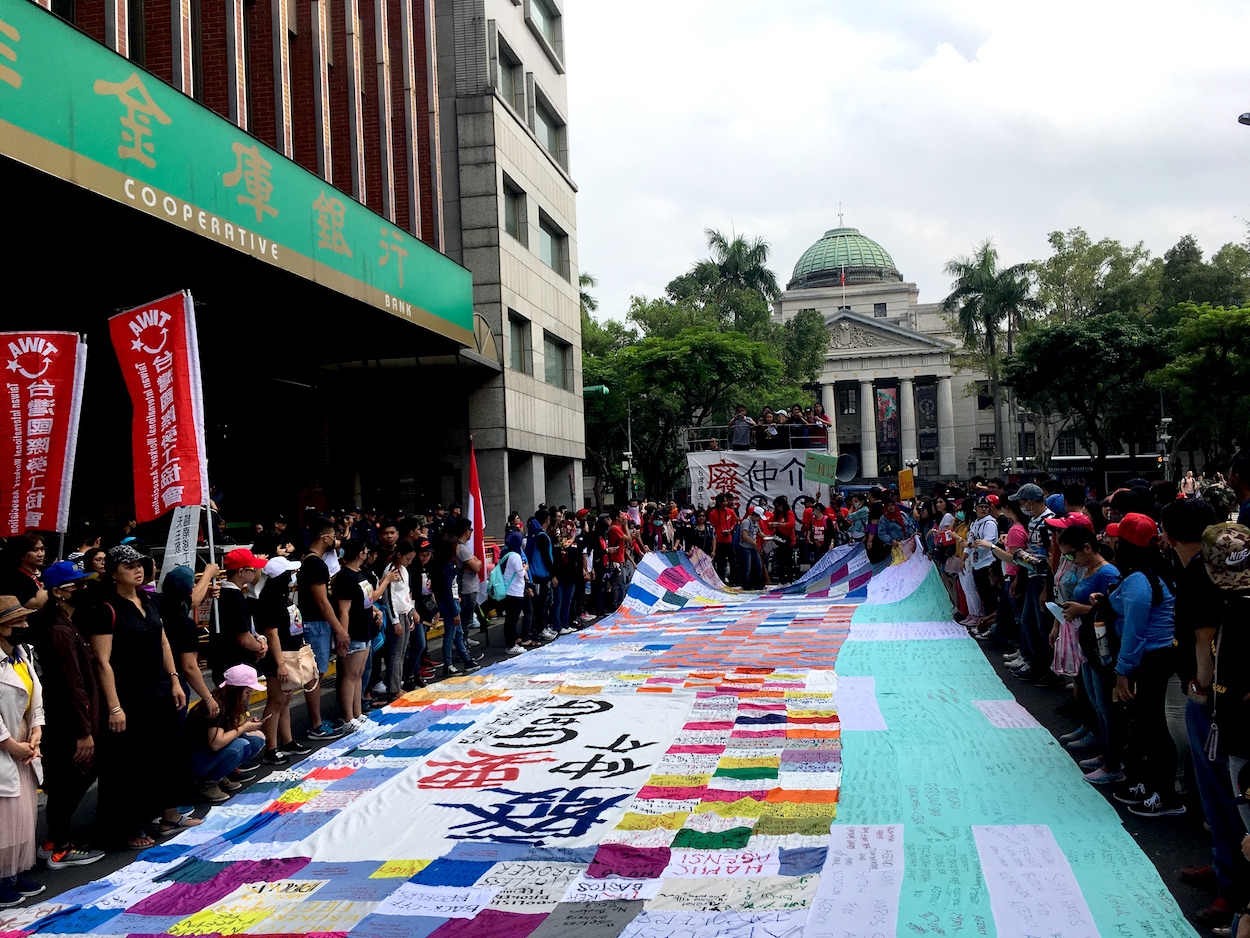by Brian Hioe
語言:
English
Photo Credit: Brian Hioe
A DEMONSTRATION BY migrant workers took place outside of the Ministry of Labor this afternoon. Just over one hundred were in attendance, demonstrators mainly consisting of migrant workers, but also with some supportive Taiwanese demonstrators, these being primarily labor organizers or youth activists.
 Photo credit: Brian Hioe
Photo credit: Brian Hioe
Migrant workers demonstrated today because April 28th is the last Sunday before May 1st, which is International Workers’ Day, and which is commemorated with a labor protest every year in Taiwan. However, unless May 1st falls on Sunday—which is usually the only day off that migrant workers have off every week, if they have one at all—most migrant workers are unable to demonstrate that day. While there usually is a migrant workers’ contingent at International Workers’ Day demonstrations, it is not large. As a result, the demonstration today was dubbed “Migrant Workers’ International Workers’ Day.”
Many migrant workers wore masks or otherwise covered their faces at the demonstration today because of the fact that they could face reprisals from their employers or the broker agencies which arrange for their employment in Taiwan if it were known that they were engaged in protest. Taiwanese law enforcement has also targeted migrant workers engaged in protest in the past, demanding their identities, or otherwise taking actions against them.
 Photo credit: Brian Hioe
Photo credit: Brian Hioe
Migrant worker groups from a number of different nationalities were present, including Filipino, Indonesian, Thai, and Vietnamese groups, among others. One demonstrator brought an Indonesian flag to the demonstration. Likewise, migrant worker groups from all across Taiwan were present. Apart from mainstays of migrant worker activism such the Taiwan International Workers’ Association, other groups present included Hsinchu Migrant and Immigrants’ Service Center, Hsinchu Catholic Migrant and Immigrants’ Service Center, Hope Workers’ Center, National Home-Based Workers’Union, Migrante Taiwan, Caritas Taiwan, the Serve the People Association, SBMI DP-LN Taiwan,
Apart from demonstrating in front of the Ministry of Labor, workers sewed together a large quilt out of patches of fabric. Each patch had a message written by a migrant worker written on it and when sewn together, the completed quilt was between 50 and 70 feet long. Workers held up the quilt while chanting slogans. Demonstrators stated that this was symbolic, given that female migrant workers in the past would make clothing out of old scraps.
 Demonstrator waving the Indonesian flag. Photo credit: Brian Hioe
Demonstrator waving the Indonesian flag. Photo credit: Brian Hioe
Musical performances also took place, including a performance of the traditional anthem of the Taiwanese labor movement, the “Workers’ Fight Song” (勞動者戰歌). Though the song was originally a Korean workers’ anthem that became adapted by workers in Taiwan, the enthusiastic reception of the song at the demonstration indicates that migrant workers have also become familiar with the song.
Migrant workers at the demonstration primarily demanded an end to the present broker system, in which broker agencies arrange for the employment of migrant workers in Taiwan as well as their transportation to and from Taiwan. However, brokers impose high surcharges on migrant workers and sometimes deduct costs from workers, such as charging them for board and lodging. Likewise, workers are arbitrarily charged different fees depending on when they come to Taiwan. It is also relatively common for migrant workers to take out large loans in order to pay off broker fees, meaning that they spend their employment in Taiwan trying to pay off their debt.
 Sewing together a quilt of protest demands. Photo credit: Brian Hioe
Sewing together a quilt of protest demands. Photo credit: Brian Hioe
To this extent, demonstrators called for a direct hiring process for workers to occur on a government to government basis, between the Taiwanese government and other governments, a practice referred to as “G to G” in protest chants. Demonstrators also called on the government to make more resources readily available to workers in languages they understand, pointing out that migrant workers have difficulty accessing information about government resources and services—even those precisely intended to benefit migrant workers—because such information is predominantly in Chinese.
Indeed, although calls to abolish the broker system have been longstanding, the Taiwanese government has historically claimed that there is still a market need for the broker system. Yet the Taiwanese government also has not taken any substantial action to regulate the excesses of the broker system either, despite that the issue is at this point well-known. Companies which adopt direct hiring practices for foreign workers are still a rarity.
 Photo credit: Brian Hioe
Photo credit: Brian Hioe
With a lack of action by the Taiwanese government and lack of sufficient public outrage to motivate politicians to action, it is to be seen how to raise public awareness of issues facing migrant workers. Key organizers of the Taiwanese labor movement are also involved in migrant worker organizing, with the demand that migrant workers’ rights be seen alongside other workers’ rights. Consequently, International Workers’ Day demonstrations usually flag the issue of migrant workers’ rights.
With over 700,000 migrant workers in Taiwan at present, migrant workers’ demonstrations are notable on the rise in the past several years. Nonetheless, it will require a great deal more public attention for any genuine improvement of conditions facing migrant workers in Taiwan, and it remains to be seen what that will take.

